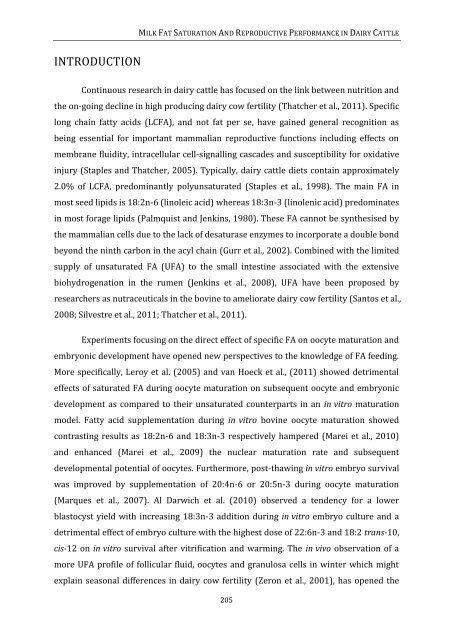view - Department of Reproduction, Obstetrics and Herd Health
view - Department of Reproduction, Obstetrics and Herd Health
view - Department of Reproduction, Obstetrics and Herd Health
You also want an ePaper? Increase the reach of your titles
YUMPU automatically turns print PDFs into web optimized ePapers that Google loves.
MILK FAT SATURATION AND REPRODUCTIVE PERFORMANCE IN DAIRY CATTLE<br />
INTRODUCTION<br />
Continuous research in dairy cattle has focused on the link between nutrition <strong>and</strong><br />
the on-going decline in high producing dairy cow fertility (Thatcher et al., 2011). Specific<br />
long chain fatty acids (LCFA), <strong>and</strong> not fat per se, have gained general recognition as<br />
being essential for important mammalian reproductive functions including effects on<br />
membrane fluidity, intracellular cell-signalling cascades <strong>and</strong> susceptibility for oxidative<br />
injury (Staples <strong>and</strong> Thatcher, 2005). Typically, dairy cattle diets contain approximately<br />
2.0% <strong>of</strong> LCFA, predominantly polyunsaturated (Staples et al., 1998). The main FA in<br />
most seed lipids is 18:2n-6 (linoleic acid) whereas 18:3n-3 (linolenic acid) predominates<br />
in most forage lipids (Palmquist <strong>and</strong> Jenkins, 1980). These FA cannot be synthesised by<br />
the mammalian cells due to the lack <strong>of</strong> desaturase enzymes to incorporate a double bond<br />
beyond the ninth carbon in the acyl chain (Gurr et al., 2002). Combined with the limited<br />
supply <strong>of</strong> unsaturated FA (UFA) to the small intestine associated with the extensive<br />
biohydrogenation in the rumen (Jenkins et al., 2008), UFA have been proposed by<br />
researchers as nutraceuticals in the bovine to ameliorate dairy cow fertility (Santos et al.,<br />
2008; Silvestre et al., 2011; Thatcher et al., 2011).<br />
Experiments focusing on the direct effect <strong>of</strong> specific FA on oocyte maturation <strong>and</strong><br />
embryonic development have opened new perspectives to the knowledge <strong>of</strong> FA feeding.<br />
More specifically, Leroy et al. (2005) <strong>and</strong> van Hoeck et al., (2011) showed detrimental<br />
effects <strong>of</strong> saturated FA during oocyte maturation on subsequent oocyte <strong>and</strong> embryonic<br />
development as compared to their unsaturated counterparts in an in vitro maturation<br />
model. Fatty acid supplementation during in vitro bovine oocyte maturation showed<br />
contrasting results as 18:2n-6 <strong>and</strong> 18:3n-3 respectively hampered (Marei et al., 2010)<br />
<strong>and</strong> enhanced (Marei et al., 2009) the nuclear maturation rate <strong>and</strong> subsequent<br />
developmental potential <strong>of</strong> oocytes. Furthermore, post-thawing in vitro embryo survival<br />
was improved by supplementation <strong>of</strong> 20:4n-6 or 20:5n-3 during oocyte maturation<br />
(Marques et al., 2007). Al Darwich et al. (2010) observed a tendency for a lower<br />
blastocyst yield with increasing 18:3n-3 addition during in vitro embryo culture <strong>and</strong> a<br />
detrimental effect <strong>of</strong> embryo culture with the highest dose <strong>of</strong> 22:6n-3 <strong>and</strong> 18:2 trans-10,<br />
cis-12 on in vitro survival after vitrification <strong>and</strong> warming. The in vivo observation <strong>of</strong> a<br />
more UFA pr<strong>of</strong>ile <strong>of</strong> follicular fluid, oocytes <strong>and</strong> granulosa cells in winter which might<br />
explain seasonal differences in dairy cow fertility (Zeron et al., 2001), has opened the<br />
205









